Eight Hundred Years of Roman Coinage
DAVID R. SEAR
(c) copyright 1986 by
Chicago Coin Club
The subject of Roman numismatics spans almost eight
hundred years, from early in the 3rd century B.C. to the Anastasian
currency reform at the very end of the 5th century A.D.
Although it began as the coinage of a relatively obscure central
Italian city state, it quickly grew to become a large scale international
currency. This was a result of Rome's military and
political expansion, first to a position of dominance in Italy, then
to supremacy in the western Mediterranean area following the
defeat of Carthage, and finally to control over the entire Mediterranean
basin with the decline and collapse of the great
Hellenistic monarchies of the east.
Throughout the later Republican period, and during
Imperial times up to the end of the 4th century A.D., Roman
coinage was produced on a vast scale, making it a rich source of
material for the present-day collector. The types are remarkably
diverse, and during Imperial times there is the added interest of
portraiture. At quite modest cost, comparing favorably with
modern coin issues, it is possible to acquire portrait pieces of
such famous (and infamous) historical personalities as Augustus,
Tiberius, Caligula, Claudius, Nero, Hadrian and Constantine, as
well as many others. My aim in this chapter is to trace the
development of this coinage from its obscure central Italian
origins through to its partial collapse in the 5th century A.D. The
recovery from this collapse was to lead to an entirely new
episode in the numismatic story - the Byzantine coinage.
At the beginning of the 3rd century B.C., about a quarter of a
century after the death of Alexander the Great, the region of
central Italy was still very much of a backwater in the political and
economic life of the Mediterranean world. That world was
dominated by the mighty Hellenistic monarchies, successor
states to Alexander's empire, in the east, and by the Carthaginians
in the west. The primitive level of the economic life of
central Italy contrasted sharply with the Greek colonies of the
south, where a sophisticated currency system, based on a silver
didrachm-stater, had already been in use for two and a half
centuries. The normal medium of exchange amongst the Italian
tribes to the north was bronze, the ores of which were abundant
in central Italy. However, the form which this currency took
over a period of many years was shapeless lumps of metal
(aes rude) of widely varying weight and with no official stamp of
guarantee. For each transaction the pieces of bronze had to be
weighed out in the scales, a laborious process indicative of the
largely pastoral way of life prevailing in the area at that time. It
is scarcely surprising that in a community consisting primarily of
farmers and herdsmen, the word for money (pecunia) should
have derived from that meaning cattle (pecus).
EARLY BRONZE COINAGE
Rome achieved political supremacy in Italy in the early
years of the 3rd century B.C. In consequence of this expansion
the Romans came to be better acquainted with the customs and
practices of their southern neighbors. As early as 326 B.C. an
alliance between Rome and the Campanian city of Neapolis had
been celebrated by an issue of bronze coins of Neopolitan type
but bearing the inscription PΩMAIUN instead of the usual
NEOΠO&Lamda;ITΩN. These small die-struck pieces were obviously
the product of the Neapolis mint, as no such establishment as yet
existed in Rome itself. However, the Romans were sufficiently
influenced by their contact with the Greek south to start producing
bronze bars (aes signatum) with designs on both faces. These
comparatively crude castings may have been preceded by the
issue of bronze artifacts (aes formatum), such as axeheads, of a
guaranteed weight. But none of these early attempts at currency
can be said to meet the definition of coinage proper.
Pieces of aes signatum are often found broken cleanly into
fragments, representing subdivisions of the full value of the bar,
so it is obvious that even at this early stage the need was being
felt for a more flexible currency system. The logical development
was the production of a full range of values in the form of
circular bronze pieces of differing weight, further distinguished
by the designs appearing on their two sides (obverse and reverse
types). Such a currency system, known as aes grave, made its
appearance at Rome in the second decade of the 3rd century B.C.
This was the outcome of the appointment, in circa 289 B.C., of
the tresviri monetales, the college of moneyers, whose function
was to oversee the establishment of a mint, in the temple of Juno
Moneta on the Capitoline hill. Thereafter, three moneyers were
appointed annually to be responsible for coin production. They
were selected from the junior aristocracy of Rome, and this
office marked for many the beginning of an illustrious senatorial
career. In the closing years of the 3rd century B.C. moneyers'
names, in monogrammatic form, began appearing on the
products of the Roman mint. But during the period of the cast aes
grave coinage, extending down to about 212 B.C., no such
development took place and the pieces are all anonymous.
The initial issue of aes grave coins from the mint of Rome
comprised a series of seven denominations, ranging from the
basic unit of the as, weighing about 322 grams, to its twentyfourth,
the semuncia. The intermediate values represented in
this, the first true Roman bronze coinage, were the half unit
(semis), the third (triens), the quarter (quadrans), the sixth
(sextans), and the twelfth (uncia). These were to remain the basic
denominations of the Republican bronze coinage, though with
inflation and the reduction of the weight standard multiples of
the as were occasionally to appear, such as the decussis (ten
asses), the quincussis (five asses), the tressis (three asses), and
the dupondius (two asses). Initially, the as represented a full
Roman pound of about 324 grams, though as time went by, there
were successive reductions in the weight of the basic unit and, in
consequence, of its fractions and multiples also. By circa 269
B.C. the as weighed approximately 270 grams, a level
maintained until about 217 B.C., when there was a drastic reduction
to half the former standard, with an as of only 130 grams
(semilibral). Rome's continuing misfortunes in the early stages of
the Second Punic War brought about an ever further decline,
with a steady reduction in the weight of the as to the triental
standard (about 88 grams) and even, circa 214 B.C., to the
quandrantal standard (66 grams). This sudden decline in the size and
weight of the aes grave coinage, in the ninth decade of the 3rd
century B.C., saw the introduction of the first struck fractions of
the as. From circa 217 B.C. many of the lower denominations
were issued as struck coins, instead of the traditional cast pieces.
Finally, with the reduction of the as to the sextantal standard of
about 44 grams (circa 211 B.C.) the basic unit itself appeared for
the first time as a struck coin, bringing to an end seven decades
of aes grave coinage and an even longer tradition of cast bronze
currency in central Italy.
The types appearing on the earlier aes grave coinage are quite
varied. A youthful Janiform head, perhaps representing the
Dioscuri, appears on the obverse of the earliest as, whilst the
reverse shows Mercury wearing his winged petasus. Other
denominations in this series have a head of Minerva (semis), a
thunderbolt and a dolphin (triens), corn grains and a hand
(quadrans), scallop shell and caduceus (sextans), knuckle bone
(uncia), and acorn (semuncia). Later series exhibit many other
types, including head of Apollo, horse's head, running boar,
prancing bull, horse, dog, and tortoise. About 225 B.C. there was
a standardization of aes grave types, and from this time onwards
the as always bears the bearded head of Janus on its obverse; the
semis has the head of Saturn; the triens the head of Minerva; the
quadrans the head of Hercules; the sextans the head of Mercury;
and the uncia the head of Roma. The reverse is the same for all
denominations - the prow of a war galley, symbolic of Rome's
newly acquired naval power developed during the recent
conflict with Carthage (First Punic War). These types were also
adopted for the struck bronze coinage which superseded the
aes grave. Marks of value were a regular feature of the bronze
coinage from its inception. The basic unit, the as, bears the
designation "I," whilst the semis is marked with an "S." The
lesser denominations were marked according to their values as
multiples of the uncia: the triens has four pellets; the quadrans
has three; the sextans has two pellets; whilst the uncia itself
bears a single pellet.
Rome was by no means the only mint engaged in the production
of aes grave. A number of Etruscan communities were also
involved, with Volaterrae (Velathri) enjoying particular
prominence. The cities of Tuder in Umbria, Hatria in Picenum, and
Luceria and Venusia in Apulia all contributed a substantial output
of cast bronze coins, in addition to other centers not all of
which have yet been identified. The types are varied and often
of considerable interest. Sometimes they bear an inscription giving
the name of the issuing authority - a feature very seldom
encountered on the cast products of Rome herself.
EARLIEST SILVER COINAGE
The earliest Roman coinage in silver closely resembles the
Greek didrachm issues of the south Italian colonies, particularly
those of Metapontum which may well have been the mint for the
Mars/horse's head coinage commencing in the second decade of
the 3rd century B.C. This issue seems to be contemporary with
the initial production of aes grave coinage at Rome, but the first
silver pieces to be struck at the Capitoline mint appear to be no
earlier than circa 269 B.C. These are the well known
Hercules/wolf and twins didrachms, the design being unmistakably
Roman, in sharp contrast to the Greco-Punic types of previous
issues. Thereafter, there were occasional changes in the types of
the silver didrachm coinage, but all issues seem to have
emanated from the Roman mint.
The next significant development was the introduction, in
circa 225 B.C., of the quadrigatus-didrachm coinage. This
coincided with the standardization of the types of the aes grave
coinage, as previously described. This, the final didrachm coinage
of Rome before the major currency reform of circa 211
B.C., bears the distinctively Roman types of Janiform
head/Jupiter in quadriga. It was issued in unprecedented quantity,
and represents the major war coinage of the Romans in the
earlier stages of the epic struggle with Hannibal (Second Punic
War). Associated with this series is Rome's first output of gold
coinage, with a remarkable reverse type showing two warriors
in an oath-taking scene. The symbolism is unmistakable, for at
the very time these staters and half-staters were produced (circa
217 B.C.) Rome was reeling from the first impact of Hannibal's
surprise descent on Italy, and was appealing for the loyalty of
her allies.
The crisis of the Second Punic War was responsible for a
complete restructuring of the Roman monetary system. The
importance of bronze as a war commodity brought about a rapid
appreciation in its value, leading to the series of drastic reductions
in the weight standard of the aes grave coinage which have
already been described. As bronze began to assume more of the
role of a token currency, as it had already done at a much earlier
date in the Greek coinage, struck pieces rapidly replaced the
crude casts of the aes grave system. This process was completed
by circa 211 B.C. with the issue of the first struck asses. At about
the same time a fundamental change took place in the silver
coinage, with the final abandonment of Rome's first precious-metal
denomination, the Greek didrachm, and its replacement
by a smaller and lighter coin. This, the silver denarius, was
destined to become the cornerstone of the Roman currency
system for centuries to come. The first issue of denarii was
accompanied by two fractional denominations - its half, the
quinarius, and its quarter, the sestertius. Yet another new silver
coin to appear at this time was the victoriatus, a piece somewhat
lighter than the denarius and, doubtless, intended to facilitate
trade with the Greek communities in the south. The denarius
was to have an illustrious history spanning four and a half
centuries; the quinarius followed a parallel course, but was only
issued intermittently for special purposes, and was never a
regular element of the currency system; the sestertius was
produced even less frequently, but under the Empire it became a
denomination of great importance, though struck in brass
instead of silver; the victoriatus was issued in quantity for a few
years after which production suddenly ceased, its raison d'etre
presumably having disappeared with the expansion of Rome's
horizons following victory in the Second Punic War. One further
innovation of the major currency reform of circa 211 B.C. was
the temporary introduction of three gold denominations, with
marks of value expressed in terms of the new "sextantal" as (60,
40 and 20). Like all issues of gold under the Roman Republic this
coinage was intended to serve only special military needs, and
production was soon discontinued. The types were the same for
all three denominations and were of a suitably military nature,
with helmeted head of Mars, god of war, on obverse, and eagle
on thunderbolt on reverse.
The great victory over Carthage in the Second Punic War, at
the close of the 3rd century B.C., was one of the major turning
points in Roman history. Almost two decades of continuous
warfare had refined the Roman army into a virtually invincible
fighting machine. The 2nd century B.C. saw Rome advance in
status from an important western Mediterranean state to a dominant
world power. The once-mighty Macedonian kingdom and
the state of Carthage were both crushed by Roman arms, and the
proud Seleucid monarch Antiochus the Great was humbled at
the famous battle of Magnesia in 190 B.C. Rome was forced into
eastern territorial expansion when the kingdom of Pergamum, in
Asia Minor, was bequeathed to the Roman people by the last of
its rulers, Attalus III, in 133 B.C. Apart from the brief episode of
the Social War, which raged in Italy from 90-88 B.C., and the
more protracted opposition of Mithradates the Great of Pontus
(120-63 B.C.), Rome now pursued her imperialist policy without
serious challenge. With their conquest of Egypt in 30 B.C., at the
very end of the Republican period, the Romans became masters
of virtually all the lands of the Mediterranean basin, either by
direct rule or through client kings.
The Roman coinage of the 2nd century B.C. consists primarily
of ever increasing numbers of silver denarii augmented by a
diminishing output of bronze denominations. The standard type
for the early denarii (Roma/Dioscuri) gradually gave way to
other designs, such as Roma/Diana in biga and Roma/Victory in
biga. Eventually, even the Roma head on obverse was replaced
by other effigies, though the process was only gradual.
Moneyers' names, at first shown only in an abbreviated form,
came to be featured more prominently both on silver and bronze
issues. The 2nd century B.C. was, without doubt, the most
conservative period of the Republican coinage, just as the 2nd
century A.D. was the most conservative of the Imperial. This was in
marked contrast to the century which followed.
RISE OF IMPERIAL RULE
The 1st century B.C. witnessed the violent transition from a
Republican to a monarchical form of government in the Roman
state. The prelude to this change had been the rise to power of
certain military commanders in the field, who began to
challenge the authority of the elected magistrates in the capital.
Rome's interests and possessions were now so far-flung that
enormous power had to be delegated to generals over long
periods of time. Such power, once exercised in distant lands with
virtually no restraint, was not easily surrendered, and it was but
a small step for the all-powerful imperator to begin thinking of
his position in terms of monarchy. Sulla, Pompey, Caesar and
Antony all dominated the political scene in their day, and at the
time of his assassination in 44 B.C. Caesar had come closer to the
crown than any man since the expulsion of Tarquinius Superbus,
the last king of Rome, in 510 B.C. But, ironically, it was not
one of the great imperators who finally succeeded in establishing
a monarchical government in Rome. This was the achievement
of Caesar's great-nephew, Octavian, a youth of only nineteen at
the time of the dictator's death. At first dismissed by Antony as
"the boy," Octavian quietly but methodically pursued his
political ambitions, cleverly exploiting his one big advantage -
his position as the adopted son and designated heir of the
"Divine Julius." The story of his eventual triumph over Antony
and Cleopatra at the naval battle of Actium in 31 B.C. is well
known, and marked another great turning-point in Roman
history. Now undisputed master of the Roman world, Octavian
set about the delicate task of establishing his constitutional position
in the government of the state, attempting not to antagonize
the many die-hard Republicans who still held high office. During
his long reign spanning four decades Augustus, as Octavian was
known from 27 B.C., laid the foundations of an imperial monarchy
which was destined to endure for five centuries in the west,
and for almost one and a half millennia in the east.
As might be expected, the turbulent 1st century B.C. has
bequeathed a rich legacy of Roman coinage. The prerogatives of
the military commanders in the field often included the right to
strike coinage to meet emergency expenses, resulting in large
scale decentralization of minting. Sulla also produced a gold
coinage, and his aureus denarius was the forerunner of the
denomination which was to occupy such an important place in
the Roman Imperial monetary system. The silver denarius
remained the principal denomination in the final period of the
Republican coinage, its types becoming extremely diverse and
often reflecting the ancestral history of the moneyer. Bronze
coinage, which was officially reduced to the semuncial standard
circa 90 B.C., continued to occupy a very subordinate position in
the monetary system.
JULIO-CLAUDIAN DYNASTY
The final two decades of the Republic, often termed the
Imperatorial period, were a time of almost incessant civil war and
disruption of normal life, a state of affairs accurately reflected by
the coinage. The various contenders for power made full use of
the propaganda value of the currency to further their own ambitions,
and the appearance of Caesar's portrait on denarii struck
in the last months of his life was an important step towards the
popular acceptance of the principle of monarchy. Ironically,
Caesar's principal assassin, the staunch Republican M. Junius
Brutus, also allowed his own effigy to appear on the remarkable
denarius commemorating the dictator's murder on the Ides of
March. Caesar had made the concept of contemporary
portraiture acceptable, and the coinage of the post-Caesarian period
abounds with the effigies of the principal contenders in the
power struggle. Foremost, of course, are the portrait heads of the
two great rivals, Antony and Octavian, but many others appear,
such as the triumvir Lepidus; Antony's brother Lucius, and his
son Marcus junior; Octavian's sister and wife of Antony,
Octavia; Sextus, the son of Pompey the Great; and the general
Labienus who sought foreign aid in Parthia for the Republican
cause. Most famous of all is the series of portrait coins coupling
Antony with his last wife, Egyptian queen Cleopatra. These
clearly show that fascinating as she may have been, the last of
the Ptolemaic line was no great beauty. The Imperatorial period
also saw an increase in the volume of the gold coinage,
presumably to help defray the heavy military expenses. Low
value bronze denominations played no part in the scheme of
things in this chaotic period.
With the accession to supreme power of Rome's first
emperor, Augustus (27 B.C. - A.D. 14), a whole new chapter in
the history of the Roman coinage is opened. The social and
economic life of the Roman state had been so disrupted by
decades of civil strife that Augustus had to introduce sweeping
reforms in almost every aspect of governmental responsibility.
The currency reform was a gradual process spanning many
years, but Augustus' main achievements were as follows: the
gold aureus was now issued as a regular part of the currency
system; production of the silver denarius, at first shared by
many mints in important centers all over the Empire, was
ultimately concentrated at Lugdunum in Gaul, which also came
to be responsible for all gold issues; aes coinage was produced in
abundance, for the first time in many generations, a sure sign
that the economic life of the state was returning to normal under
the aegis of the Augustan peace. The highest denomination in the
new base metal coinage was the sestertius, valued at one quarter
of the denarius. This was struck in orichalcum (brass) as was its
half, the dupondius. Another metal, copper, was used for the as
(one-sixteenth denarius) and its quarter, the quadrans. A less
frequent denomination was the semis (half as) which, like the
sestertius and dupondius, was struck in orichalcum. Production
of the aes coinage was eventually concentrated in Rome, though
the Gallic mints of Lugdunum and Nemausus each had a
substantial output during the Augustan period. Special
arrangements were made for the wealthy and important province
of Asia, where triple-denarii (cistophori) were struck at various
centers, such as Ephesus and Pergamum, in continuation of
the Pergamene tradition and for the convenience of the local
population.
The reformed monetary system of Augustus set the pattern
for the Roman Imperial coinage for centuries to come, until the
economy of the state collapsed in the dark days of the mid-3rd
century A.D. Augustus' successors made minor changes to the
currency but the basic system was left unaltered, a tribute to the
thoroughness of the reformer's work. Tiberius' remarkably
conservative precious metal coinage was all produced at the
Lugdunum mint. Many contemporary imitations of these issues
exist, evidence of the extensive trade with the East at this time. It
was probably during the reign of Caligula (A.D. 37-41) that the
minting of gold and silver was resumed at Rome, for the first
time since the earlier part of Augustus' reign. A feature of
Caligula's coinage was the extent to which he honored his
relatives, both living and dead. Claudius (A.D. 41-54) was
responsible for the introduction of certain allegorical
personifications, such as Spes (hope) and Libertas (liberty), a theme
which was to be of immense importance on the coinage of the
following two and a half centuries. Like his nephew before him,
Claudius went to great lengths to commemorate and honor
different members of the Imperial Julio-Claudian family. The last
representative of the dynasty, Nero, whose reign ended with his
suicide in A.D. 68, issued a fascinating and varied coinage.
Imperial portraiture now reached a very high artistic level,
especially in the case of Nero's splendid sestertii, which were all
produced in the latter part of the reign. He did, however, reduce
the weights of both the gold aureus and the silver denarius, the
first stage in the slow but inexorable debasement of the Imperial
coinage.
FLAVIAN DYNASTY
The Julio-Claudian dynasty ended as it had begun, in the
flames of civil war. Three emperors - Galba, Otho and Vitellius
- passed in rapid succession. Brief though their tenure of power
was, they have left behind a remarkably extensive numismatic
record. Stability was restored by the elderly general Vespasian,
whose decade of rule (A.D. 69-79) saw an immense output of
coinage in all metals and a remarkable proliferation of reverse
types, a pattern which was to be followed by his successors. At
the time of their bid for Imperial power Vespasian and his elder
son Titus had been engaged in the quelling of the great Jewish
Revolt (A.D. 66-70). Titus' ultimate success in this task was
commemorated on an extensive series of coins issued in gold, silver
and aes, most celebrated of which are the handsome sestertii
with reverse IVDAEA CAPTA. The Flavian dynasty, founded by
Vespasian, consisted merely of himself and his two sons, Titus
(A.D. 79-81) and Domitian (A.D. 81-96). Titus' brief reign was
notable for the completion and dedication of Rome's great
Flavian Amphitheater, better known as the Colosseum, and the
famous eruption of Mount Vesuvius which buried the towns of
Pompeii and Herculaneum. The first of these events was
commemorated on a very rare sestertius, with a bird's-eye view of
the celebrated arena on the reverse. Dominating the coinage of
Domitian, last of the Flavian emperors, are representations of
Minerva, his patron deity. Also prominent are references to the
German wars, though Agricola's spectacular successes in
northern Britain in the opening years of the reign were totally
ignored, doubtless due to imperial jealousy and fear of enhancing
the victor's popularity. Assassination of the hated tyrant
(September, A.D. 96) brought to a violent end to Rome's second
Imperial dynasty.
THE ADOPTIVE EMPERORS
The period which followed, generally known as the era of
the Adoptive Emperors, was a time of comparative peace and
prosperity such as the Empire had seldom known in the past and
was certainly never to enjoy again. For eighty-four years (A.D.
96-180) the government was in the hands of a remarkable succession
of wise and enlightened rulers, each selected by his
predecessor on merit rather than for reasons of family ties. It
was, perhaps, fortunate that none of the Emperors Nerva,
Trajan, Hadrian or Antoninus Pius had sons whom they would have
been tempted to elevate in preference to more worthy
candidates for the throne. Hadrian's adoption of the plainly
unsuitable L. Aelius Caesar in A.D. 136 has given rise to speculation
that the heir may have been his own natural son. Following
Aelius' premature death, on New Year's Day A.D. 138, Hadrian
then made the best possible choice on merit, Antoninus, but
stipulated that the young son of Aelius Caesar, Lucius Verus,
should be designated as joint heir of Antoninus, together with
Marcus Aurelius. The adoptive system eventually broke down
when Marcus Aurelius elevated his own worthless son,
Commodus, to the rank of co-emperor. Commodus' assassination on
New Year's Eve, A.D. 192, following a disgraceful reign filled
with all kinds of excesses, brought to a sad end Rome's golden
age of the 2nd century A.D.
The coinage of this remarkably settled period was, as might
be expected, very uniform with no experimentation in the
currency system and production almost totally monopolized by the
mint of Rome. The content, however, was varied and often of
considerable interest. Nerva's short reign (A.D. 96-98) saw many
important propaganda types, including continual appeals to the
armed forces, whose loyalty was in some doubt following the
violent overthrow of the Flavian dynasty. The extensive coinage
of Trajan (A.D. 98-117) contains numerous references to his
Dacian wars, in commemoration of which the great column was
erected which remains to this day a landmark of Rome. Concern
for his lack of popularity at the beginning of his reign, due in part
to the somewhat dubious circumstances of his adoption, led
Hadrian (A.D. 117-138) to seek public approval through various
acts of munificence. One of these, the cancellation of arrears of
taxation totalling 900 million sestertii, was commemorated on
coins issued in A.D. 119. Hadrian's empire-wide travels receive
extensive coverage, with types honoring almost every province,
from Britain to Syria and Egypt. Comparatively large issues were
made in the name of Hadrian's wife, Vibia Sabina, the first
empress to be so extensively commemorated on the Roman coinage.
Another interesting feature of the coinage of this reign is the
Greek Imperial series in the name of the deceased Bithynian
youth Antinous, favorite of Hadrian, whose tragic drowning in
the Nile (A.D. 130) embittered the emperor's final years. The
stability and self-assurance of the Roman state during the reign
of Antoninus Pius (A.D. 138-161) is well reflected on the
Imperial coinage. The high international prestige enjoyed by
Rome's emperor is vividly illustrated by types showing
Antoninus bestowing royal status on the kings of Armenia and of
the Quadi, a Germanic tribe.
The reign of Marcus Aurelius (A.D. 161-180) was historically
significant as it witnessed the first division of Imperial authority.
Aurelius shared his throne, first with Lucius Verus (A.D.
161-169), and later with his own son Commodus (from A.D.
177). The harmony of the joint Augusti was widely advertised on
the coinage, notably by types depicting the Emperors Aurelius
and Verus clasping hands. Of particular historical significance is
the beautiful gold aureus type of Verus, showing in pictorial
form his settlement of the Armenian problem in A.D. 163. The
emperor sits atop a platform, flanked by his officers, with the
Roman nominee for the Armenian throne, Sohaemus, standing
before him at the foot of the platform. Commodus' coinage (A.D.
177-192), especially that produced towards the end of his reign,
increasingly reflects the megalomaniac tendencies of this unworthy
son of a noble father. Some types show him in the guise of
the hero Hercules, of whom he considered himself the reincarnation,
prompting him to give public displays of his prowess in
the arena, combatting wild beasts. So ended in disgrace the
celebrated Antonine dynasty which had done so much to
enhance the prestige of the Imperial throne.
DEBASEMENT OF COINAGE
Half a decade of bloodshed and civil strife was the legacy of
Commodus' reign of terror. Pertinax labored valiantly to turn
back the clock and restore the fine tradition of Antonine government,
but was assassinated by his own guards, who were resentful
of stricter discipline, after a reign of less than three months.
The death of Pertinax, and the disgraceful elevation by his
murderers of the senator Didius Julianus, aroused such a furor in
the provinces that three rival emperors were almost
simultaneously proclaimed in widely separated areas of the
Empire. One of these avengers of Pertinax, Septimius Severus,
ultimately triumphed over his rivals, Pescennius Niger and
Clodius Albinus. But the state had to pay a heavy price for this
bloody episode of civil war. Severus (A.D. 193-211), the founder
of a new dynasty, owed everything to his loyal troops, and
showed his thanks by pampering the army, increasing their pay
and granting them many additional privileges. His elder son and
ultimate successor, Caracalla, followed the same principles thus
sowing the seeds of future military anarchy which, ironically,
was to bring about the downfall of the Severan dynasty itself in
A.D. 235. The heavy cost of the civil wars, and of his liberality
towards his soldiers, obliged Severus to debase the purity of the
silver coinage, an evil expedient in which he was imitated by
many of his successors, with catastrophic results. But the
Severan coinage is, nevertheless, generally well struck from
neatly engraved dies, and the types are full of interest. Strong
emphasis is placed on the dynastic principle, to which end many
precious metal types were produced combining the portraits of
various members of the Imperial family. Of special architectural
interest is a denarius issued in A.D. 206 depicting the famous
triumphal arch of Severus, which still stands to this day in the
Roman Forum. Not all of the earlier Severan precious metal
coinage was produced in Rome. One result of the civil wars
following the murder of Pertinax was the establishment of a
mint, or mints, in the East which remained active for many years
after the defeat and death of Pescennius Niger. Laodicea in Syria
was probably the principal eastern mint for the earlier Severan
coinage. Its products are not difficult to differentiate from those
of Rome, purely on stylistic grounds. One major innovation in
the currency system, made by Caracalla in A.D. 215, was the
introduction of a silver double-denarius, usually termed an antoninianus
after the emperor's official name of Antoninus.
The Severan dynasty was briefly interrupted, in A.D.
217-218, by the usurpation of Macrinus and his young son
Diadumenian. Macrinus continued the issue of antoniniani
initiated by his predecessor, though they were produced in much
smaller numbers than the traditional denarii. Under the last two
emperors of the Severan dynasty, Elagabalus (A.D. 218-222) and
Severus Alexander (A.D. 222-235), coin production remained at
a high level in Rome, especially of the debased silver denarii,
though sestertii were also struck in quantity under Alexander.
Antoniniani were produced by Elagabalus, but their issue ceased
after a short time, and sixteen years were to elapse before the
denomination was reintroduced. A Syrian mint, probably
Antioch, was operative for precious metal denominations under
Elagabalus and for the early years of Alexander's reign. The
latter was very much under the influence of his domineering
mother, Julia Mamaea, whose issues of silver denarii and brass
sestertii were on a large scale.
Severus Alexander and Julia Mamaea were murdered by
mutinous soldiers in A.D. 235. With the downfall of the Severan
dynasty the Roman Imperial coinage went into a rapid decline, a
crisis which was only partially alleviated by Aurelian's currency
reform in the early 270s. One of the first signs of impending trouble
was a drastic reduction in the volume of gold issues. Production
of the double-denarius (antoninianus), discontinued at or
before the accession of Alexander, was resumed by the joint
Emperors Balbinus and Pupienus in A.D. 238. Within a short
space of time the antoninianus had driven the denarius out of
circulation, thus bringing to an end four and a half centuries of
continuous production of the most famous denomination of
Roman coinage. The new standard denomination, the antoninianus,
was issued in ever increasing quantities, from the reign
of Gordian III (A.D. 238-244) through to Diocletian's great
reform of the coinage in the final decade of the 3rd century. The
weights of individual gold coins show a marked decline at this
time, though the purity of the metal remains high. The aes,
though still produced in some numbers, exhibit a tendency to be
struck on small and irregular flans.
Although he reigned only briefly in the mid-3rd century,
Trajan Decius (A.D 249-251) bravely attempted to make a stand
against the rapid decline in the political and economic situation
in the Roman state. By adopting the name of Trajan at the outset
of his reign he clearly showed his intention to restore the old
Roman virtues. Emphasis to this policy was given by the issue of
a remarkable series of antoniniani honoring eleven of Decius'
Imperial predecessors, from Augustus to Severus Alexander.
These gave a fascinating insight into which past rulers were
highly regarded in mid-3rd century Rome, and which were not.
Notable by their absence were such names as Julius Caesar,
Claudius and Pertinax, whilst surprising inclusions were
Commodus and Severus Alexander, especially as the latter had never
even been deified. A further innovation by Trajan Decius was
the introduction of a handsome new aes denomination, the
double sestertius, a coin of truly medallic appearance.
Following the death of the heroic Decius on the field of
battle, fighting the Empire's dangerous new enemies the Goths
(summer 251), there was a further rapid deterioration in the state
of affairs, both military and economic. Trebonianus Gallus (A.D.
251-253) attempted to halt the decline in the weight of the gold
coinage by the introduction of a double aureus (binio) closely
resembling the antoninianus. The brief reign of Aemilian (A.D.
253) saw the issue of a number of interesting types, including
extremely rare antoniniani in the name of his wife, Cornelia
Supera. These troubled times also witnessed the usurpation at
Emisa (Syria) of a certain Uranius Antoninus, about whom very
little is known. His remarkable coinage consists of gold aurei,
with highly distinctive reverse types, and provincial style billon
tetradrachms and bronzes.
DISINTEGRATION OF THE MONETARY SYSTEM
With the accession in A.D. 253 of Valerian and his son
Gallienus the final chapter in the dissolution of the Augustan
monetary system is opened. Following Valerian's capture by the
Persians in 260 the Romans temporarily lost effective control of
much of the East, the initiative ultimately passing to the rulers of
the desert kingdom of Palmyra. Just prior to this catastrophe the
western provinces of Gaul, Britain and Spain had been detached
from the authority of the central government by the rebellion of
Postumus, commander of the Rhine legions. He and his
successors maintained an independent state for about fourteen
years. In the midst of this chaos, with the Empire showing every
sign of total and permanent disintegration, the Imperial coinage
was suffering a disastrous decline. The silver antoniniani,
already seriously debased by the early 250s, sank rapidly to the
level of small bronze coins, seldom showing any trace of silver
content. The state was virtually bankrupt, and with the collapse
of the silver coinage the issue of aes denominations came to an
almost complete stop. The extensive provincial bronze coinage
in the East suffered a similar fate, and many Greek Imperial
mints made their final issues in the names of Gallienus and his
wife, the Empress Salonina. Although the purity of the gold was
maintained, the weights of individual specimens vary widely,
and there appears to have been little attempt to adhere to any
particular standard. In the Gallic Empire of Postumus the
monetary crisis was less severe. His attractive gold coinage was
struck on a heavy weight standard whilst his antoniniani, though
very debased, generally present an appearance far superior to
those issued by Gallienus. Postumus even managed to produce a
substantial output of aes coinage, including some unusually large
pieces which probably circulated as double sestertii. His main
mint establishment seems to have been situated at Colonia
Agrippina (Cologne), only one of many new minting centers, the
proliferation of which was a feature of the later 3rd century
coinage. Rome was beginning to lose its pre-eminence, not just
as the center of coin production but as the political and strategic
heart of the Empire.
The dark days of the 260s were followed by a period of
partial recovery, intitiated by Claudius II Gothicus (A.D. 268-270).
The improvement was maintained and given further impetus by
the vigorous action of Aurelian (A.D. 270-275). This elderly but
energetic ruler not only recovered the lost western provinces
from the successors of Postumus, but also defeated the forces of
the remarkable Queen Zenobia of Palmyra. Zenobia and her son
Vabalathus had been issuing billon tetradrachms from the mint
of Alexandria in Egypt, and antoniniani from Syrian Antioch.
They adorned Aurelian's great triumph through the streets of
Rome, together with the Tetrici, father and son, who were the
last rulers of the Gallic Empire. Aurelian also found time to
undertake a partial reform of the Imperial coinage, which had
sunk to such a low level. It appears to have been beyond the
resources of the state to reintroduce a pure silver coinage at this
time, but the size and weight of the antoninianus were
increased, and its silver content fixed at about 5%. Aes denominations
reappeared but were produced only on a limited scale, and
were issued even more sparingly by Aurelian's successors. Gold
was now coined on a more regular basis and included some double
aurei. The monetary system as restored by Aurelian lasted
for about two decades, until Diocletian (A.D. 284-305) introduced
his sweeping reforms commencing about 294. The
intervening years saw many changes in government, for these were
dangerous times, and even emperors of the valor and ability of
Aurelian and Probus were not safe from the assassin's sword.
With Diocletian's currency reform the Imperial coinage
takes on a whole new aspect. Silver coins of high quality, and
corresponding in weight to the Neronian denarius, were reintroduced
for the first time in many generations. The name usually
given to this new denomination is argenteus. The debased
antoninianus was gradually phased out and replaced by a new
bronze coin usually referred to as the follis. This piece was of
about the same size as the old copper as, but its value in circulation
was considerably enhanced by its 5% silver content. Diocletian's
arrangements had to be modified in the light of the
realities of the economic situation: the silver argenteus did not
long remain in circulation and its issue quickly ceased, the result
of a serious official miscalculation of its relative value in circulation;
whilst the follis underwent a rapid series of reductions in
size and weight, a process which continued for almost half a
century until the time of Constantius II and Constans. A few years
after Diocletian's abdication in A.D. 305, Constantine the Great
made a fundamental change in the gold coinage, abandoning the
traditional aureus denomination, struck at the rate of 60 to the
pound, in favor of a somewhat lighter coin, the solidus, weighing
1/72 of a pound. The solidus was ultimately destined to have a
longer and more fascinating history than the aureus, or even the
denarius, as it went on to become the principal coin of the late
Roman state and subsequently of the Byzantine Empire.
TRANSFER OF POWER FROM ROME
The reign of Constantine the Great (A.D. 307-337) was
another turning point in the history of the Roman Empire.
Although quite different in their characters and methods,
Diocletian and Constantine seem to have held similar views on
what was required to reinvigorate the worn-out late Roman
state. Decentralization of government and Rome's consequent
loss of political supremacy, which first occurred under Diocletian's
tetrarchy system, was brought to its logical conclusion
with the establishment, by Constantine, of a new capital city.
Constantinople, dedicated in A.D. 330, was built on the site of
ancient Byzantium. At the meeting place of Europe and Asia,
and relatively close to the troublesome Danubian frontier, the
new capital occupied a position of great strategic importance.
Rivalry between the old capital, Rome, and Constantine's city on
the Bosphorus was to become a feature of late Roman and Byzantine
history, though the religious aspect of the competition rapidly
superseded the political. Constantine's adoption of Christianity
as the state religion of the Empire made Constantinople an
important religious center from the time of its foundation. But the
authority of the patriarch was openly challenged by the pope in
Rome who, as the occupant of the throne of St. Peter, claimed
supremacy in ecclesiastical affairs.
The shift in political emphasis from west to east, beginning
with Diocletian at the end of the 3rd century, was a major factor
in the eventual downfall of the Western Empire in the second
half of the 5th century. With very few exceptions, such as
Constantine II in A.D. 337 and Valentinian I in 364, the senior
emperor reserved for himself the government of the eastern
provinces with his residence at Constantinople. The junior
colleague occupied the western throne, and the division between
the two halves of the Empire became increasingly marked.
Theodosius I (A.D. 379-395) was the last emperor to wield
undisputed authority over the entire Roman state.
Barbarian pressure on the frontiers increased markedly in
the second half of the 4th century. The Emperor Valens lost his
life in a great battle fought against the invading Goths at
Hadrianopolis in Thrace (A.D. 378), and the growing influence
of the Germanic element in the Roman army itself weakened the
Empire's resolve to fight back. The disintegration of the West
commenced early in the 5th century, with a Vandalic onslaught
on Gaul in 406, and a Visigothic invasion of Italy, culminating in
the capture and sack, by Alaric, of Rome itself in 410. The long
and almost consecutive reigns of two weak and ineffective
emperors in the West, Honorius (395-423) and Valentinian III
(425-455), contributed to the rapid political decline. Many
usurpers rose up to challenge the authority of Honorius, notably
Constantine III (407-411) and Jovinus (411-413), but this only
served to further weaken the state. In the time of Valentinian III
the disintegration proceeded apace, the heaviest blow being the
loss of North Africa to the Vandals under their powerful King
Gaiseric. Following Valentinian's murder in A.D. 455, the
Western Empire lingered for another two decades. Its rulers
were, for the most part, shadowy figures with little real authority,
the reins of power being firmly in the hands of their
Germanic generals and chief ministers. The line ended with the
deposition of Romulus Augustus in A.D. 476 whereupon Italy,
like the remainder of the former western provinces, became a
barbarian kingdom.
The Eastern Empire fared better in these troubled times. It
successfully withstood a number of barbarian invasions, and
thanks to the wise policies of the Emperor Leo I (457-474) it rid
itself of the powerful and destructive Germanic element in the
army. With the disappearance of the Empire in the West, the
eastern provinces are now commonly referred to as the Byzantine
state, though the Byzantines never ceased calling
themselves 'Romans.' The Eastern Empire consolidated its position
under a succession of effective, if not brilliant, rulers and
laid the foundations for a further millennium of turbulent
history, providing the important link between the classical
world and the medieval.
COMPLEXITIES OF THE COINAGE
A knowledge of the outline of Roman history in the 4th and
5th centuries is vital to an understanding of the complexities of
the coinage during this period. As we have seen, Diocletian's
reformed currency system already stood in disarray by the time
Constantine made himself sole master of the Empire in 324. The
gold aureus had been replaced by the lighter solidus, whilst the
issue of silver coins had long since ceased. The bronze follis had
declined to the size of the old denarius, and was to be reduced
still further over the succeeding two decades. The number of
active mints, however, remained high, in continuation of the
expanded network set up by Diocletian as part of his program of
reforms. Throughout most of the 4th century the operational
mint establishment varied from approximately fifteen to twenty.
This was a far cry from the virtual monopoly enjoyed by Rome
for so long.
Constantine's new gold coin, the solidus, was accompanied
by two fractional gold denominations, the semissis (half solidus),
and a 9-siliqua piece weighing 9/24 of the solidus. Later in the
century this enigmatic little piece was replaced by a more convenient
fractional coin, the tremissis (1/3 solidus, or 8 siliquae).
Silver was reintroduced by Constantine in the latter part of his
reign, though on a very limited scale when compared with
Diocletian's issues. The weight standard used was still that of the
argenteus, though the coin now seems to have gone by the name
of siliqua. At some point during the sole reign of Constantius II
(A.D. 350-360) there was a drastic reduction in the weight of the
siliqua to 2/3 of its former level, suggesting that silver had been
retariffed at a much higher value in relation to gold. Thereafter,
until the end of the 4th century, the siliqua was coined in great
quantity, especially at mints in the western provinces. A double
denomination, the miliarense, was also minted from time to
time. The eventual demise of the silver coinage coincided with
the political disintegration of the West.
The story of the bronze coinage is one of continual decline,
with occasional short-lived attempts to halt the seemingly
inevitable process. About 346 Constantius II and his brother
Constans replaced the now tiny bronze follis with a larger piece,
usually termed the centenionalis. The usurper Magnentius
(350-353) and Julian II, the last emperor of the house of Constantine
(360-363) both attempted to reintroduce a large bronze
piece, the maiorina, but all such efforts seemed doomed to
failure. Most bronze coins issued in the closing decades of the
4th century were either small or very small, and we have no
information regarding what names they may originally have
borne.
With the opening of the 5th century the stage was set for the
final drama in the disintegration of the Western Roman Empire.
A marked change in the Imperial coinage can also be dated to
this time. Gold solidi were issued in ever increasing numbers,
symptomatic of the vast sums the Empire was now having to pay
mercenary troops for the defense of its borders. Barbarian tribes
also had to be bribed and tribute paid to successful invaders. All
this depleted the treasury to such an extent that the government
was no longer able to issue lower value silver and bronze coins to
facilitate the normal economic life of the Empire. For everyday
transactions the citizens must have resorted to barter, a state of
affairs which existed throughout most of the 5th century. Silver
was only coined in minute quantities, even in the East, and the
only bronze coin in regular production was the tiny nummus.
This piece was so small that there was scarcely space to place the
emperor's name and titles on the obverse, so a monogram of the
imperial name became the standard reverse type. On the gold
solidi the ever widening gulf between the Eastern and Western
Empires was made even more apparent by a division of types.
The western solidi maintained the traditional profile effigy on
the obverse, whilst the reverse was devoted to a standing figure
of the emperor. In the East, however, the facing military bust
with spear and shield, initiated by Constantius II in the mid-4th
century, was the standard obverse type, with a standing figure of
Victory holding a long cross on reverse. Only in the dying days
of the Western Empire did its solidus types finally fall in line
with the Constantinopolitan pattern. The number of mint
establishments declined dramatically as the 5th century
progressed, due both to the reduction in coin output and to the
dislocation caused by barbarian invasion. Rome, Ravenna and
Milan survived longest in the West, whilst Constantinople was
the major producer of currency in the East, augmented by a
limited output from Thessalonica.
In A.D. 498 the elderly Emperor Anastasius (491-518) carried
out a sweeping reform of the bronze coinage. The tiny nummi
were supplemented by a whole range of new multiple
denominations, such as the follis (40 nummi), the half follis (20
nummi) and the quarter follis or decanummium (10 nummi).
Later, a pentanummium (5 nummi) was added. Each of these
new coins was clearly marked with its value as a multiple of the
nummus, and their large scale issue from an expanding mint
system meant a return to the more settled economic conditions
of earlier times. Thus ended the eight hundred-year story of the
Roman coinage, with the birth of a new tradition, the Byzantine,
which was destined to endure for an even longer period of time.
Roman Republic
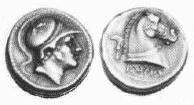
1. Silver didrachm, 241-235 B.C.
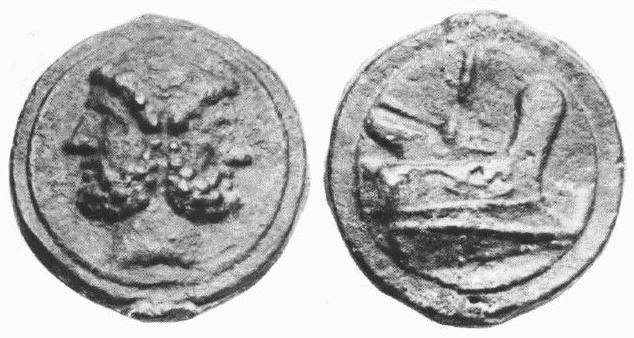
2. Aes Grave as, 225-217 B.C.
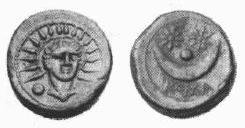
3. Struck bronze uncia, 217-235 B.C.
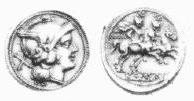
4. Silver denarius, 211 B.C.

5. Gold 20 asses, 211 B.C.

6. Silver victoriatus, 211 B.C.
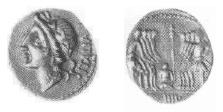
7. Social War, silver denarius, 90-88 B.C.
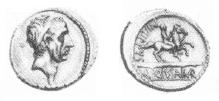
8. L. Marcus Philippus, silver denarius, 56 B.C.
Roman Imperatorial
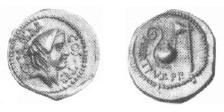
9. Julius Caesar, gold aureus, 46 B.C.

10. Julius Caesar, silver portrait denarius, 44 B.C.
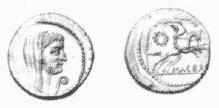
11. Mark Antony, silver portrait denarius, 44 B.C.
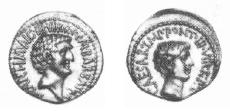
12. Mark Antony and Octavian, silver denarius, 41 B.C.

13. Octavian, silver denarius, commemorating defeat of Antony and Cleopatra, 28 B.C.
Roman Imperial

14. Augustus, 27 B.C. - 14 A.D., silver cistophorus.
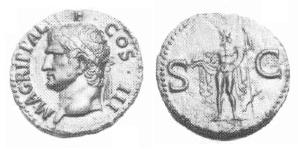
15. Marcus Agippa, died 12 B.C., copper as.
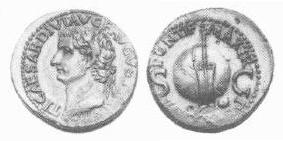
16. Tiberius, A.D. 14-37, copper as.
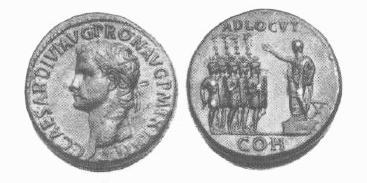
17. Caligula, A.D. 37-41, brass sestertius.
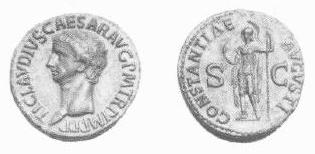
18. Claudius, A.D. 41-54, copper as.
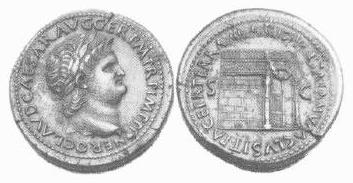
19. Nero, A.D. 54-68, brass sestertius.
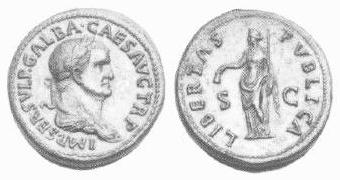
20. Galba, A.D. 68-69, brass sestertius.
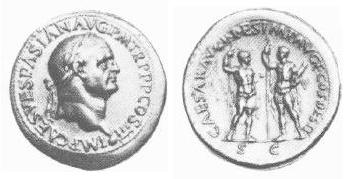
21. Vespasian, A.D. 69-79, brass sestertius.
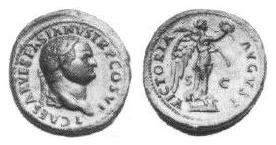
22. Titus, A.D.79-81, copper as (under Vespasian).
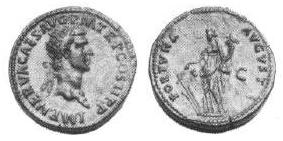
23. Nerva, A.D. 96-98, brass dupondius.

24. Trajan, A.D. 98-117, gold aureus.
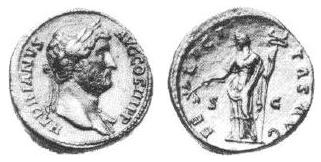
25. Hadrian, A.D. 117-138, brass sestertius.
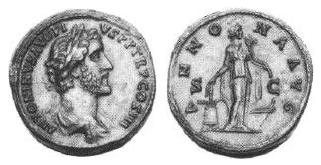
26. Antoninus Pius, A.D. 138-161, brass sestertius.
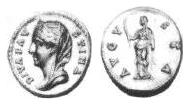
27. Faustina Senior, wife of Antoninus, gold aureus.
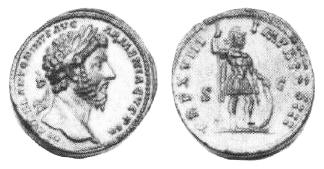
28. Marcus Aurelius, A.D. 161-180, brass sestertius.

29. Faustina Junior, wife of Aurelius, gold aureus.

30. Lucius Verus, A.D. 161-169, brass sestertius.

31. Commodus, A.D. 177-192, gold aureus.

32. Pertinax, A.D. 193, silver denarius.

33. Didius Julianus, A.D. 193, silver denarius.
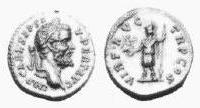
34. Septimus Severus, A.D. 193-211, gold aureus.
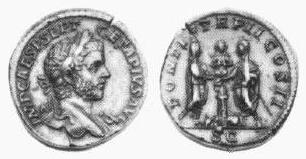
35. Geta, A.D. 209-211, brass sestertius.
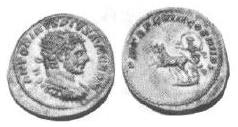
36. Caracalla, A.D. 198-217, silver antoninianus.
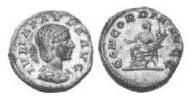
37. Julia Paula, first wife of Elagabalus, A.D. 219, silver denarius.
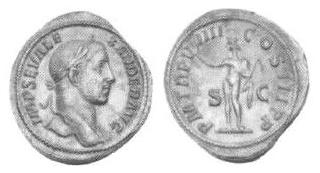
38. Severus Alexander, A.D. 222-235, brass sestertius.
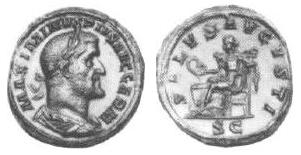
39. Maximinus I, A.D. 235-238, brass sestertius.
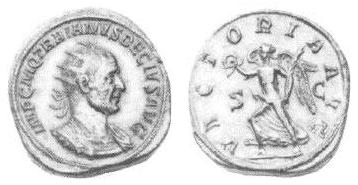
40. Trajan Decius, A.D. 249-251, brass double-sestertius.

41. Trajan Decius, A.D. 249-251, silver 'restoration' antoniniani,
with portraits of Titus, Nerva, and Trajan.
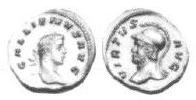
42. Gallienus, A.D. 253-268, gold aureus.

43. Florianus, A.D. 276, billon antoninianus.
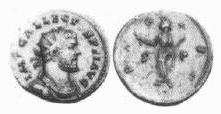
44. Allectus, usurper in Britain, A.D. 293-296, billon antoninianus.

45. Diocletian, A.D. 284-305, gold aureus.

46. Diocletian, A.D. 284-305, silver argentus.
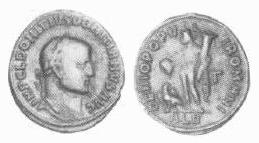
47. Domitus Domitianus, usurper in Egypt, A.D. 296-297, billon follis.
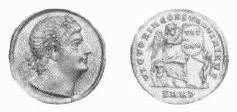
48. Constantine I, the Great, A.D. 307-337, gold solidus.
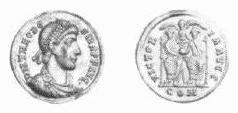
49. Thodosius I, the Great, A.D. 379-395, gold solidus.
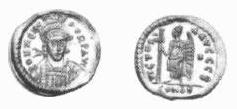
50. Zeno, A.D. 474-491, gold solidus.
(Photographs by Andrew Daneman and Nancy Norsworthy.)
return to
Perspectives in Numismatics

















































